

Vowel. In phonetics, a vowel is a sound in spoken language, such as an English ah!
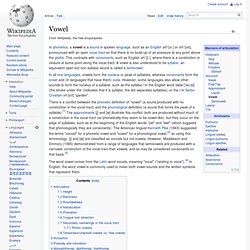
[ɑː] or oh! [oʊ], pronounced with an open vocal tract so that there is no build-up of air pressure at any point above the glottis. This contrasts with consonants, such as English sh! [ʃː], where there is a constriction or closure at some point along the vocal tract. A vowel is also understood to be syllabic: an equivalent open but non-syllabic sound is called a semivowel. In all oral languages, vowels form the nucleus or peak of syllables, whereas consonants form the onset and (in languages that have them) coda.
The word vowel comes from the Latin word vocalis, meaning "vocal" ("relating to voice").[4] In English, the word vowel is commonly used to mean both vowel sounds and the written symbols that represent them. Articulation[edit] English vowel chart. By Tomasz P.
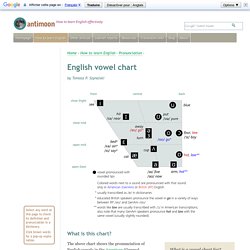
Szynalski © Tomasz P. Szynalski, Antimoon.com What is this chart? What is a vowel chart for? It can tell you how English vowels are pronounced relative to each other. You can also learn how English vowels are pronounced relative to vowels in other languages. A word of caution: comparing different vowel charts can be tricky. The above chart shows the pronunciation of English vowels in the American (General American) and British (Received Pronunciation) dialects. 1/3 Vowels, Vowel Formants and Vowel Modification. (Page 1 of 3) Vowels The term ‘vowel’ is commonly used to mean both vowel sounds and the written symbols that represent them.
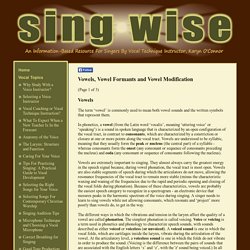
In phonetics, a vowel (from the Latin word ‘vocalis’, meaning ‘uttering voice’ or ‘speaking’) is a sound in spoken language that is characterized by an open configuration of the vocal tract, in contrast to consonants, which are characterized by a constriction or closure at one or more points along the vocal tract. Vowels are understood to be syllabic, meaning that they usually form the peak or nucleus (the central part) of a syllable - whereas consonants form the onset (any consonant or sequence of consonants preceding the nucleus) and coda (any consonant or sequence of consonants following the nucleus).
Vowels are extremely important to singing. The different ways in which the vibrations and tension in the larynx affect the quality of a vowel are called phonation. This isn’t the case with consonants and nasal sounds, however. IPA Symbols For Vowels. 2/3 Vowels, Vowel Formants and Vowel Modification. (Page 2 of 3) Vowel Formants Each phoneme is distinguished by its own unique pattern in the spectrogram.
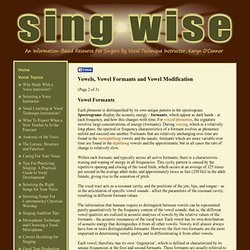
Spectrograms display the acoustic energy – formants, which appear as dark bands - at each frequency, and how this changes with time. For voiced phonemes, the signature involves large concentrations of energy (formants). During voicing, which is a relatively long phase, the spectral or frequency characteristics of a formant evolves as phonemes unfold and succeed one another. Within each formant, and typically across all active formants, there is a characteristic waxing and waning of energy in all frequencies.
3/3 Vowels, Vowel Formants and Vowel Modification. (Page 3 of 3) Vowel Modification (‘Copertura’) Vowel modification is an intentional, slight adjustment made to the sound (acoustics) of a vowel, by altering the basic way in which a vowel is articulated, with the goal of attaining more comfortable and pleasing tone production, especially in the higher part of the singer’s range.
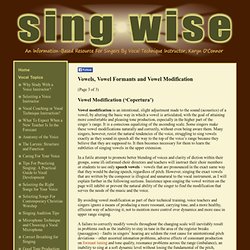
It is a conscious equalizing of the ascending scale. Some singers make these vowel modifications naturally and correctly, without even being aware them. Many singers, however, resist the natural tendencies of the voice, struggling to sing vowels exactly as they sound in speech all the way to the top of the voice’s range because they believe that they are supposed to. By avoiding vowel modification as part of their technical training, voice teachers and singers ignore a means of producing a more resonant, carrying tone, and a more healthy, efficient way of achieving it, not to mention more control over dynamics and more ease in upper range singing. Acoustics. Phonetic reference. The following is a table with all the phonetic symbols used in Antimoon PerfectPronunciation software.
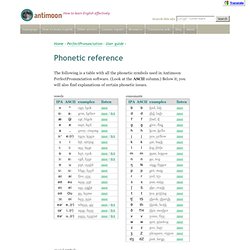
(Look at the ASCII column.) Below it, you will also find explanations of certain phonetic issues. Key The ASCII column gives the symbol in the Antimoon ASCII Phonetic Alphabet used in PerfectPronunciation. Vocale. Da Wikipedia, l'enciclopedia libera.

Vocali In fonetica, una vocale è un fono che ha come realizzazione prevalente un vocoide. La parola vocale deriva dal latino vocalis, che significa "emettente voce" o "parlante". Dal punto di vista articolatorio, una vocale è un suono prodotto mediante la vibrazione delle corde vocali e senza frapporre ulteriori ostacoli al flusso dell'aria così fatto risonare. Fonologia della lingua italiana. Da Wikipedia, l'enciclopedia libera.

Questa voce tratta la fonologia della lingua italiana: si espongono quindi i fonemi, gli allofoni, le varianti libere e le regole fonotattiche della lingua italiana. Il sistema di riferimento è quello dell'italiano standard. Fonemi[modifica | modifica sorgente] L'italiano (nella sua forma standard) prevede i seguenti fonemi. Consonanti[modifica | modifica sorgente] Tutte le consonanti (tranne /z/, /j/ e /w/) possono essere fonologicamente geminate all'interno di parola tra vocali o tra vocale e /l/, /r/, /j/ o /w/.
Vocali[modifica | modifica sorgente]